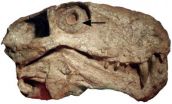(Press-News.org) Methods have been developed to try to identify and correct for bias in the fossil record but new research from the Universities of Bristol and Bath, suggests many of these correction methods may actually be misleading.
The study, led by Dr Alex Dunhill, formerly at the Universities of Bristol and Bath and now at the University of Leeds, explored the rich and well-studied fossil record of Great Britain. Professional geological work has been done in the British Isles for over 200 years and the British Geological Survey (dating from the 1830s) has amassed enormous, detailed knowledge of every inch of the rocks and fossils of the islands.
Together with collaborators from the Universities of Bristol and Bergen, Dr Dunhill compared biodiversity through the last 550 million years of the British fossil record against a number of geological and environmental factors including the area of sedimentary rock, the number of recorded fossil collections and the number of named geological 'formations'. All of these measures have been used as yardsticks against which the quality of the fossil record can be assessed – but the new study casts doubt on their usefulness.
Dr Dunhill said: "We suspected that the similar patterns displayed by the rock and fossil records were due to external factors rather than the number of fossils being simply dictated by the amount of accessible rock. Our work shows this is true. Factors such as counts of geological formations and collections cannot be used to correct biodiversity in the fossil record."
The study benefits from the application of advanced mathematical techniques that not only identify whether two data sets correlate, but also whether one drives the other.
The results show that out of all the geological factors, only the area of preserved rock drives biodiversity. Therefore, the other geological factors – counts of fossil collections and geological formations – are not independent measures of bias in the fossil record.
Co-author, Bjarte Hannisdal from the University of Bergen, said: "We can learn more by analysing old data in new ways, than by analysing new data in old ways."
This discovery fundamentally alters the way we view the diversity of life through time. It shows that both the preservation of rock and the preservation of fossils were probably driven by external environmental factors like climate change and sea level. This better explains the similarities between the rock and fossil records, as both responding to the same external factors. The alternative idea, that rock preservation was driving the fossil record is now strongly queried by this study. Perhaps the record of biodiversity in the fossil record is more accurate than previously feared.
Professor Michael Benton from the University of Bristol, another co-author of the study, said: "Palaeontologists are right to be cautious about the quality of the fossil record, but perhaps some have been too cautious. The sequence of fossils in the rocks more or less tells us the story of the history of life, and we have sensible ways of dealing with uncertainty. Some recent work on 'correcting' the fossil record by using formation counts may produce nonsense results."
The research is published today in Nature Communications.
INFORMATION:
Paper
'Disentangling rock record bias and common-cause from redundancy in the British fossil record' by Alexander M. Dunhill, Bjarte Hannisdal, and Michael J. Benton in Nature Communications, 5:4818 (doi: 10.1038/ncomms5818)
How good is the fossil record?
2014-09-04
ELSE PRESS RELEASES FROM THIS DATE:
To clean air and beyond: Catching greenhouse gases with advanced membranes
2014-09-04
Researchers in Japan have engineered a membrane with advanced features capable of removing harmful greenhouse gases from the atmosphere. Their findings, published in the British journal Nature Communications, may one day contribute to lower greenhouse gas emissions and cleaner skies.
Greenhouse gases, originating from industrial processes and the burning of fossil fuels, blanket the earth and are the culprits behind current global warming woes. The most abundant among them is carbon dioxide, which made up 84% of the United State's greenhouse gases in 2012, and can linger ...
Curb sitting time to protect aging DNA and possibly extend lifespan
2014-09-04
Reducing sedentary activity appears to lengthen telomeres, which sit on the end of chromosomes, the DNA storage units in each cell, the findings show.
Telomeres are important because they stop chromosomes from 'fraying' or clumping together and 'scrambling' the genetic codes they contain, performing a role similar to the plastic tips on the end of shoelaces, to which they have been likened.
Longevity and a healthy lifestyle have been linked to telomere length, but whether physical activity can make any difference, is not clear.
The researchers therefore analysed the ...
The Lancet Diabetes & Endocrinology: Global epidemic of diabetes threatens to jeopardise further progress in tuberculosis control
2014-09-04
The rapid increase in rates of type 2 diabetes* in low- and middle-income countries where tuberculosis (TB) is endemic could hamper global efforts to control and eliminate TB, according to a new three-part Series about TB and diabetes, published in The Lancet Diabetes & Endocrinology.
The Series indicates that 15% of adult TB cases worldwide are already attributable to diabetes. These diabetes-associated cases correspond to over 1 million cases a year, with more than 40% occurring in India and China alone. If diabetes rates continue to rise out of control, the present ...
Ancient mammal relatives were active at night 100 million years before origin of mammals
2014-09-04
Most living mammals are active at night (or nocturnal), and many other mammal species are active during twilight conditions. It has long been thought that the transition to nocturnality occurred at about the same time as mammals evolved, around 200 million years ago. This thinking was based on on features such as the large brains of mammals (good for processing information from senses like hearing, touch, and smell) and the details of light-sensitive chemicals in the eyes of mammals.
It turns out that nocturnal activity might have a much older origin among ancient mammal ...
E-cigarettes may promote illicit drug use and addiction
2014-09-04
VIDEO:
Columbia researchers discuss how e-cigarettes may promote illicit drug use and addiction.
Click here for more information.
NEW YORK, NY (September 3, 2014)—Like conventional cigarettes, electronic cigarettes (or
e-cigarettes) may function as a "gateway drug"—a drug that lowers the threshold for addiction to
other substances, such as marijuana and cocaine—according to the 120th Shattuck lecture, presented to the Massachusetts Medical Society by Columbia researchers ...
Blood test for 'nicked' protein predicts prostate cancer treatment response
2014-09-04
Prostate cancer patients whose tumors contain a shortened protein called AR-V7, which can be detected in the blood, are less likely to respond to two widely used drugs for metastatic prostate cancer, according to results of a study led by researchers at the Johns Hopkins Kimmel Cancer Center. If large-scale studies validate the findings, the investigators say men with detectable blood levels of AR-V7 should avoid these two drugs and instead take other medicines to treat their prostate cancer. A report on the work is described online Sept. 3 in the New England Journal of ...
Airline pilots, cabin crews have higher incidence of melanoma
2014-09-03
Bottom Line: Airline pilots and cabin crews appear to have twice the incidence of melanoma as the general population.
Author: Martina Sanlorenzo, M.D., of the University of California, San Francisco, and colleagues.
Background: Melanoma is a common cancer in the United States; in 2014, 76,100 people will be diagnosed with the skin cancer and 9,710 people will die. Several studies have suggested a higher incidence of melanoma in pilots and flight crew. Flight-based workers are thought to have a greater occupational hazard risk of melanoma because of increased altitude-related ...
Obsessive compulsive disorder diagnosis linked to higher rates of schizophrenia
2014-09-03
Bottom Line: A diagnosis of obsessive-compulsive disorder (OCD) appears to be associated with higher rates of schizophrenia and schizophrenia spectrum disorders.
Authors: Sandra M. Meier, Ph.D., of Aarhus University, Denmark, and colleagues.
Background: OCD and schizophrenia are distinct and infrequently overlapping disorders. But some studies have suggested higher rates of co-existing illness with the two disorders in patients.
How the Study Was Conducted: The authors assessed the potential relationship between the two disorders using data from Danish registers. ...
Genetic 'hotspot' linked to endometrial cancer aggressiveness
2014-09-03
Parents of twins often tell them apart through subtle differences such as facial expression, moles, voice tone and gait. Similarly, physicians treating women with endometrial cancer must be able to distinguish between different versions of this disease form that, on the surface, appear the same.
With endometrial cancer, the most common gynecological cancer in the western world and the fourth most prevalent in the U.S., it can literally be a matter of life and death. Mortality rates from this cancer have nearly tripled in the last 25 years and are thought to be attributed ...
Can sleep loss affect your brain size?
2014-09-03
MINNEAPOLIS – Sleep difficulties may be linked to faster rates of decline in brain volume, according to a study published in the September 3, 2014, online issue of Neurology®, the medical journal of the American Academy of Neurology.
Sleep has been proposed to be "the brain's housekeeper", serving to repair and restore the brain.
The study included 147 adults 20 and 84 years old. Researchers examined the link between sleep difficulties, such as having trouble falling asleep or staying asleep at night, and brain volume.
All participants underwent two MRI brain scans, ...



